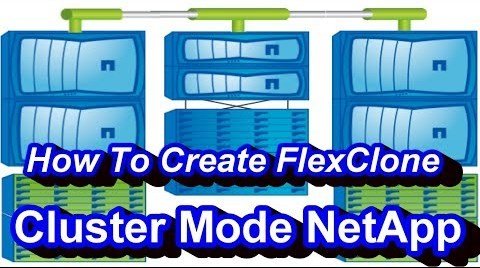In this post, we will discuss what is FlexClone volume in NetApp cluster mode. Additionally, we will discuss how to create a flex clone in the command line.

Flexclone volume is also called a flexible clone. This is one of the storage efficiency features in NetApp. Flex clones are the point in time copy of a source volume that you can use for testing purposes.
After flex clone creation whatever changes happen in any of the volumes, it does not affect each other data. Due to which, it is a good option for testing.
Clone volume shares the same space of its source volume means it will not consume any extra space from its container aggregate. If you want flex clone to be a separate volume then you can use the split command.
How To Create FlexClone Volume?
We can create a FlexClone volume with CLI and GUI. In this post, we will create a clone volume in the Command line.
You can also refer to the YouTube videos from san&nasTechie for creating FlexClone.
Steps To Create FlexClone Volume
Below is the step by step guide to creating a clone volume in NetApp cluster mode.
Step 1. Check FlexClone Licence
The first step is to check the license for FlexClone. You need a license to enable this feature. You can execute the below command to see the license list.
cluster::> license show
If you do not find the license you must get a license from NetApp sales representative. Otherwise, proceed to the next step.
Step 2. Create a FlexClone volume
You can create a FlexClone volume by using the “volume clone create” command. The below command creates a read-write clone volume vol1_clone from the parent volume vol1.
volume clone create -vserver vs0 -flexclone vol1_clone -type RW -parent-volume vol1
You can also create a clone volume using a snapshot. However, the volume must be a DP volume.
The following command creates a data protection clone volume vol_dp_clone from the parent volume dp_vol by using the base Snapshot copy snap1:
volume clone create -vserver vs1 -flexclone vol_dp_clone -type DP -parent-volume dp_vol -parent-snapshot snap1
Step 3. Split Clone Volume
Clone volume does not have its own space rather it uses its parent volumes space. If you want the clone volume to have its own storage then you need split clone relationship.
The split operation creates a copy of the data in a new volume. First, you must check available space in aggregate because the new volume will consume space from it.
You can execute the below command to estimate the space that the new volume going to consume.
cluster1::> volume clone show -estimate -vserver vs1 -flexclone clone1 -parent-volume volume1
If there is enough space in aggregate than split the clone volume. After this command, the new volume consumes space from its container aggregate.
cluster1::> volume clone split start -vserver vs1 -flexclone clone1
Once the split operation is complete you can verify the status as well. You should see the clone-volume status as false.
cluster1::> volume show -volume clone1 -fields clone-volume
volume clone-volume
——- —— ————
vs1 clone1 false

